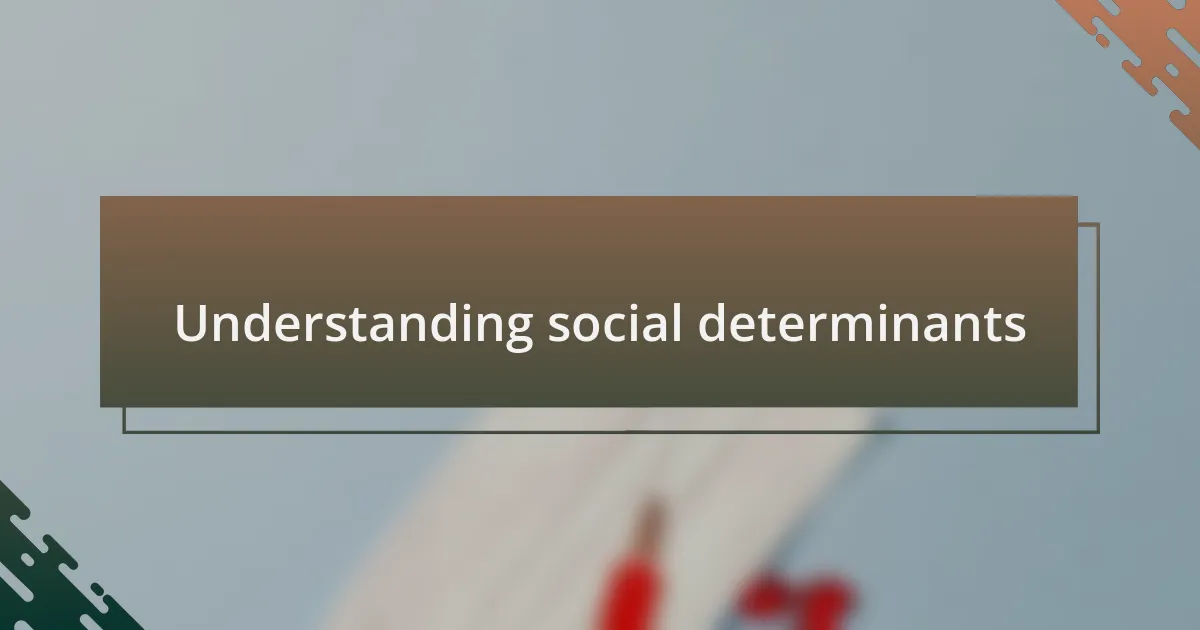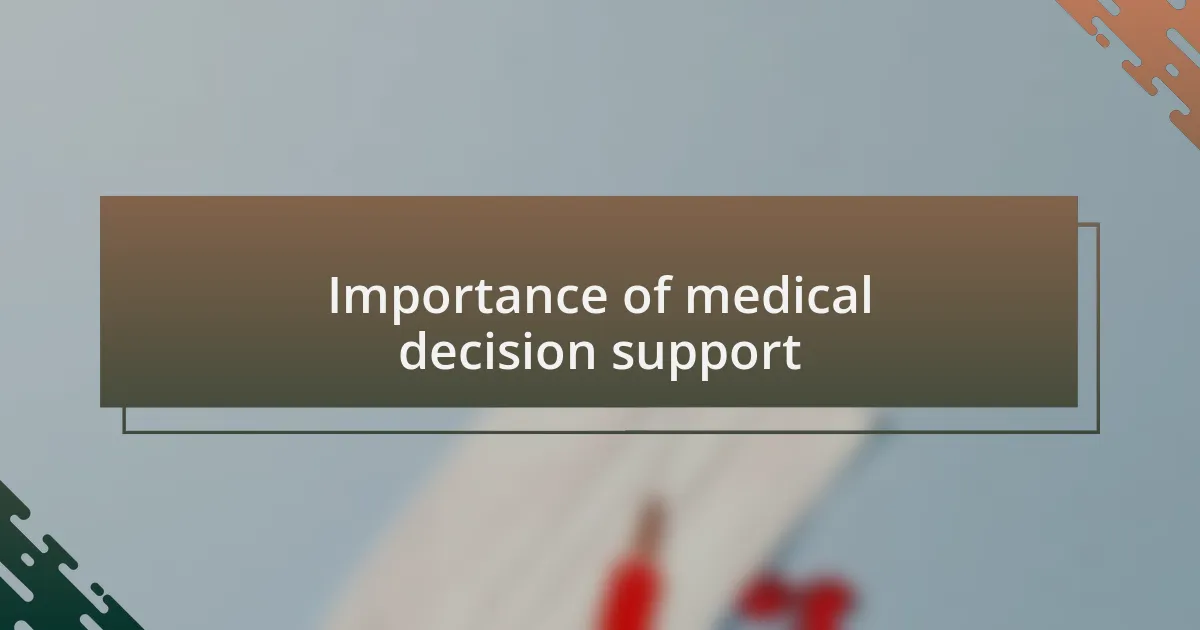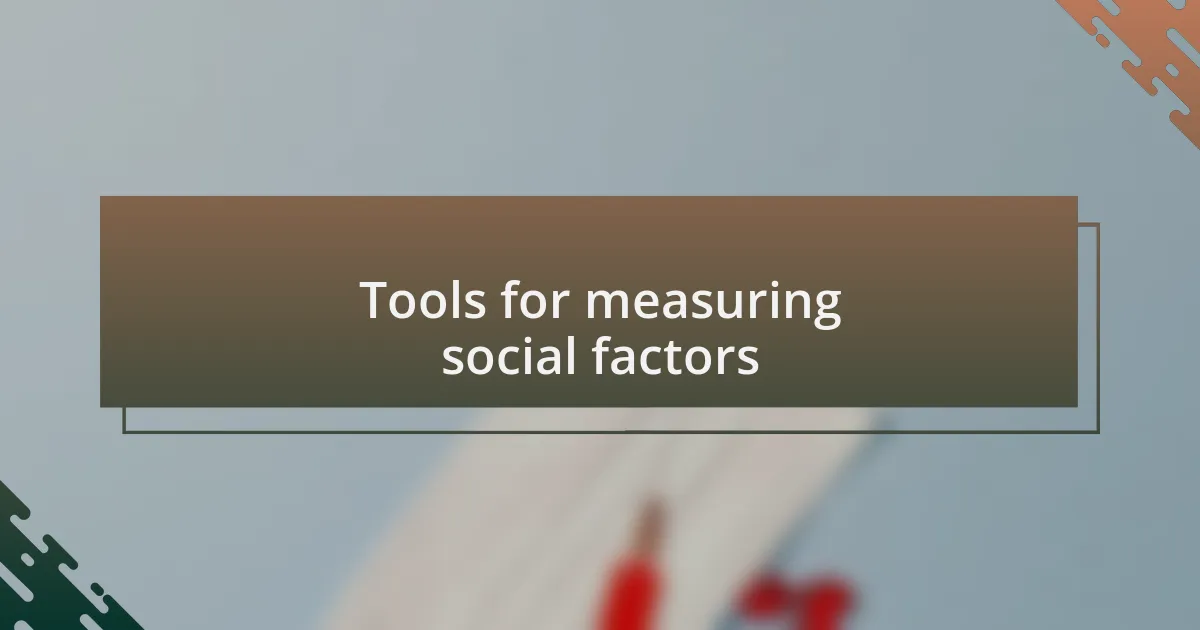Key takeaways:
- Social determinants of health, such as socioeconomic status and education, significantly impact health outcomes and highlight disparities within the healthcare system.
- Evidence-based practices improve patient engagement and outcomes by integrating local health data and fostering collaboration among healthcare providers.
- Medical decision support systems streamline workflows and enhance personalized care, emphasizing the importance of addressing individual patient circumstances.
- Tools like the Social Vulnerability Index and Area Deprivation Index help quantify social factors, allowing healthcare providers to target interventions more effectively.

Understanding social determinants
Social determinants of health are the conditions in which people are born, grow, live, work, and age. I often reflect on how my surroundings shaped my health journey – whether it was the availability of fresh food or access to quality healthcare. Have you ever considered how your neighborhood influences your well-being?
When I study these determinants, I find that they go beyond just individual choices; they encompass factors like socioeconomic status, education, and even social support networks. It sometimes astonishes me how someone’s income can dramatically alter their health outcomes. Considering this, how equitable is our healthcare system when so many are affected by these external factors?
Exploring social determinants helps illuminate the root causes of health disparities that I’ve observed throughout my career. For instance, working in a diverse community, I’ve seen firsthand how a lack of transportation restricts access to necessary medical appointments. Do we recognize the extent to which our environment, culture, and relationships shape our health experiences?

Role of evidence-based practices
Evidence-based practices play a crucial role in delivering healthcare that genuinely meets the needs of diverse populations. I remember a project where our team analyzed treatment protocols in a community clinic. It was eye-opening to see how integrating local health data into our decision-making improved patient engagement and outcomes. Doesn’t it make sense that when practices are grounded in evidence tailored to specific social contexts, they resonate more with individuals?
Furthermore, these practices serve as a bridge between clinical knowledge and real-world application. I once collaborated with a group of healthcare providers who were skeptical about changing established routines. However, after presenting compelling research that showcased the benefits of evidence-based methods, their perspectives shifted. How often do we overlook the power of data in shaping our practices and ultimately, our patients’ well-being?
The continuous evaluation of evidence-based practices ensures that healthcare evolves alongside societal changes, leading to improved health literacy among patients. In my experience, when practitioners embrace ongoing education about the social determinants influencing health, they can craft more impactful interventions. Aren’t we all striving for a health system that not only treats but also empowers individuals to make informed choices based on their unique circumstances?

Importance of medical decision support
Medical decision support systems are essential in navigating the complexities of patient care. I recall a time when I worked with a team on implementing a new decision support tool in our clinic. Initially, there was some resistance among the staff. However, as soon as they started using it to analyze patient data and treatment options, they saw firsthand how it streamlined their workflow and improved patient outcomes. Can you imagine the frustrations of making choices without such valuable guidance?
Moreover, these systems foster collaboration among healthcare providers, enhancing the quality of care delivered to patients. A few years ago, I observed a multidisciplinary case review where decision support tools played a pivotal role in uniting doctors, nurses, and specialists. By facilitating open discussions about treatment plans informed by evidence, we were able to address patients’ needs comprehensively. Have you ever witnessed the difference collaboration makes in clinical settings?
Finally, the integration of medical decision support into everyday practice emphasizes the importance of personalized care. During a community health initiative, I encountered a patient with unique challenges that standard protocols overlooked. By leveraging decision support systems, we tailored our approach effectively, leading to a significant turnaround in their health journey. Isn’t it empowering to utilize technology that recognizes and adapts to the specific circumstances of each individual?

Tools for measuring social factors
When it comes to understanding social factors in healthcare, tools like the Social Vulnerability Index (SVI) become invaluable. I remember integrating this tool into our assessments, and it opened my eyes to the profound impact social determinants can have on patient outcomes. Have you ever used a scoring system that quantified elements you thought were merely anecdotal? The SVI takes into account factors such as income, education, and housing stability, enabling a nuanced view that helps practitioners target interventions more effectively.
Similarly, the Area Deprivation Index (ADI) is another essential tool I’ve turned to in my practice. This tool goes a step further by mapping geographical areas based on various social and economic variables. One time, I used the ADI to identify patients living in high-deprivation areas who were frequently readmitted. It was striking to see how correlating their living conditions provided clarity on the underlying issues we weren’t initially considering. Have you had moments where data revealed what was previously hidden?
On a more personal note, I’ve also found value in qualitative assessments, such as patient interviews focused on social challenges. These conversations don’t just generate data; they foster trust and rapport. I distinctly recall a patient who shared their struggle with transportation barriers, which contributed to missed appointments. Understanding this human aspect makes it so much easier to strategize effective care solutions. Isn’t it fascinating how the nuances of personal stories can reshape our approach to treatment?

Applying assessments in practice
Assessing the impact of social determinants in practice is not just about collecting data; it’s about translating that data into meaningful action. For instance, I once reviewed community health data that highlighted a significant portion of our patients lacked reliable access to fresh food. After sharing this insight with a local food bank, we collaborated on a program that enabled outreach to those neighborhoods. Have you ever felt the satisfaction of seeing data turn into a lifeline for your community?
Integrating these assessments into patient care plans requires a thoughtful approach. I recall working with a hospital team to develop care pathways that considered not just a patient’s clinical needs but also their social context. For example, we discussed how a patient’s chronic illness was exacerbated by a lack of social support systems. Why is it that we sometimes overlook the simple fact that comprehensive care encompasses far more than just medical history?
Finally, embracing a team-based atmosphere is pivotal when applying these assessments. I’ve had moments where nurses, social workers, and even administrative staff contributed insights that transformed our understanding of a patient’s circumstances. One such instance involved a collaborative meeting where the role of housing instability was finally addressed. It is these collective discussions that elevate our practices and bridge the gap between social determinants and health outcomes. How often do you think we undervalue the diverse perspectives within our teams?